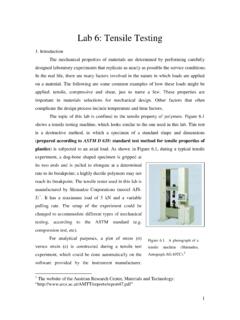Transcription of Lab 9: Tensile Testing - Iowa State University
1 Lab 6: Tensile Testing 1. Introduction The mechanical properties of materials are determined by performing carefully designed laboratory experiments that replicate as nearly as possible the service conditions. In the real life, there are many factors involved in the nature in which loads are applied on a material. The following are some common examples of how these loads might be applied: Tensile , compressive and shear, just to name a few. These properties are important in materials selections for mechanical design.
2 Other factors that often complicate the design process include temperature and time factors. The topic of this lab is confined to the Tensile property of polymers. Figure shows a Tensile Testing machine, which looks similar to the one used in this lab. This test is a destructive method, in which a specimen of a standard shape and dimensions (prepared according to ASTM D 638: standard test method for Tensile properties of plastics) is subjected to an axial load.
3 As shown in Figure , during a typical Tensile experiment, a dog-bone shaped specimen is gripped at its two ends and is pulled to elongate at a determined rate to its breakpoint; a highly ductile polymers may not reach its breakpoint. The Tensile tester used in this lab is manufactured by Shimadzu Corporations (model AJS-J)1. It has a maximum load of 5 kN and a variable pulling rate. The setup of the experiment could be changed to accommodate different types of mechanical Testing , according to the ASTM standard ( compression test, etc).
4 For analytical purposes, a plot of stress ( ) versus strain ( ) is constructed during a Tensile test experiment, which could be done automatically on the software provided by the instrument manufacturer. 1 The website of the Austrian Research Center, Materials and Technology: Figure A photograph of a Tensile machine (Shimadzu, Autograph AG-10TC).2 1 Stress, in metric system, is usually measured in N/m2 or Pa, such that 1 N/m2 = 1 Pa.
5 From the experiment, the value of stress is calculated by dividing the amount of force (F) applied by the machine in the axial direction by its cross-sectional area (A), which is measured prior to running the experiment. Mathematically, it is expressed in Equation The strain values, which have no units, can be calculated using Equation In the equation, L is the instantaneous length of the specimen and L0 is the initial length. AF= (Equation ) 00 LLL = (Equation ) A typical stress-strain curve would look like Figure The stress-strain curve shown in Figure is an example of a text-book stress-strain curve.
6 In reality, not all stress-strain curves perfectly resemble the one shown in Figure This stress-strain curve is typical for ductile metallic elements. Another thing to take note is that Figure shows an engineering stress-strain curve. Once a material reaches its ultimate stress strength of the stress-strain curve, its cross-sectional area would reduce dramatically, a term known as necking. When the computer software plots the stress-strain curve, it assumes that the cross sectional area stays constant throughout the experiment, even during necking, therefore causing the curve to slope down.
7 The real stress-strain curve could be constructed directly by installing a gauge, which measures the change in the cross sectional area of the specimen throughout the experiment. Theoretically, even Figure Various regions and points on the stress-strain 2 without measuring the cross-sectional area of the specimen during the Tensile experiment, the true stress-strain curve could still be constructed by assuming that the volume of the material stays the same.
8 Using this concept, both the true stress ( T) and the true strain ( T) could be calculated using Equation 3 and Equation 4 respectively. The derivation of these equations is beyond the scope of this lab report. Consult any standard mechanics textbook to learn more about these equations. In these equations, L0 refers to the initial length of the specimen, L refers to the instantaneous length and refers to the instantaneous stress. 0 LLT = (Equation ) 0 TLlnL = (Equation ) Figure also shows that a stress-strain curve is divided into four regions, which are as follows: elastic, yielding, strain hardening (commonly occurs in metallic materials) and necking.
9 The area under the curve represents the amount of energy needed to accomplish each of the events. The total area under the curve (up to the point of fracture) is also known as the modulus of toughness. This represents the amount of energy needed to break the sample, which could be compared to the impact energy of the sample, determined using Impact test. The area under the linear region of the curve is known as the modulus of resilience.
10 This represents the minimum amount of energy needed to deform the sample. The linear region of the curve of Figure , which is called the elastic region (past this region, is called the plastic region), is the region where a material behaves elastically. The material will return to its original shape when a force is released while the material is in its elastic region. The slope of the curve, which could be calculated using Equation is a constant, and is an intrinsic property of a material, is known as the elastic modulus, E.

